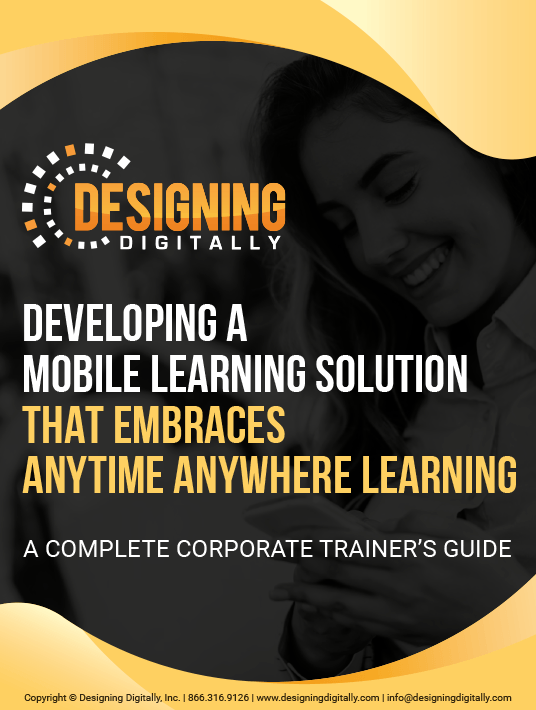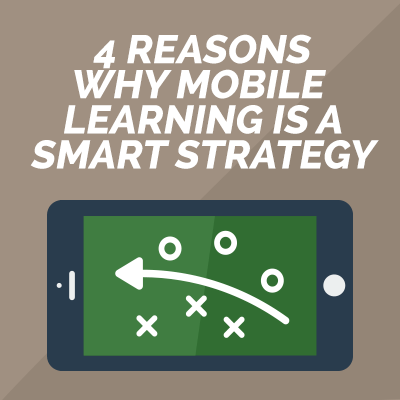Creating A Learning On The Go Strategy? What You Should And Should Not Do
Almost every employee in the workforce carries a smartphone with them wherever they go. As a result, you can provide mobile-friendly training so they can access it whenever they need. Releasing mobile learning, or mLearning, isn’t as simple as pushing a button. You need to carefully plan out a learning on the go strategy in order to be successful. Here are 6 suggestions on what to do and what to avoid when you create training for learners to use on smartphones and tablets:

1. Do: Investigate Learners’ Needs
Mobile learning is a great way to distribute Just-In-Time learning or on-the-job resources. One application may be designing a troubleshooting guide for auto mechanics. They can pull up the information on their phone while they’re standing next to the car in the garage. However, office employees who sit at their desks are more likely to use their computer to look up an answer, so creating a mobile reference guide would be futile. Similarly, employees who fly for work may benefit from mobile courses they can take waiting at the airport. Yet, regional sales associates who drive themselves to meetings cannot interact with an mLearning module while they’re behind the wheel. Find out how your learners will benefit from a learning on the go solution. You can ask them directly, or seek input from their managers about how they spend their work time. Also, ask what specific topics and skills learners need to learn or improve. Don’t assume you know what they need to learn. At Designing Digitally, we conduct a thorough Needs Analysis to explore the audience, skills gap, and technology parameters of each project.
2. Don’t: Anticipate A Silver Bullet Module
As you investigate needs, you’ll hopefully come up with a long list of learning topics and ways to implement mobile training solutions. Don’t expect to create one mLearning module that fills all those needs. It is impossible to develop a silver bullet that solves all the problems in an organization. You essentially have two options. The first is to create a series of resources that addresses all the topics. Or, if you can only develop one training resource right now, resort to option two: identify the highest priority and focus only on that area.
Whichever route you’re taking, it will help to group the ideas in a logical way so you can start to sort the list. You may arrange them by similar topics, skill level, setting where it is used, etc. Apply microlearning principles to divide the material into small, concentrated areas. Then, assess your development capabilities and learner needs to decide if you should create a mobile game, responsive mLearning module, phone app, or mobile-friendly website. Map out the purpose of each module or training resource, regardless of how many you are creating. Include details such as where learners will access it, why they’ll be motivated to open it when they’ll need it, and what information it will contain. These parameters will help you manage expectations and ensure each resource effectively achieves its purpose.
3. Do: Make Content Easy To Find
Learners who access learning on the go, especially if they’re looking for a quick answer, don’t want to waste time trying to find what they need. It is often helpful to provide a simple, straightforward menu they can use to navigate between sections. Be sure the information in the module or website is organized in a fashion that will make sense to learners. If possible, include a search bar where they can type a keyword and see a list of places it is referenced in the module. Some work environments open an opportunity to use QR codes. For instance, in a warehouse, you could place QR codes on certain pieces of equipment. Employees can scan the code on their phone to open the mobile learning solution that teaches them how to use or store the equipment. Evolving capabilities of Augmented Reality (AR) will lend to easier ways to get content in front of your learners when they need it.
4. Don’t: Rush The Testing Phase
After you’ve planned, designed, and developed your mobile learning solution, you’ll enter the crucial phase of testing. This phase is extremely tedious with mobile projects because you need to test on multiple devices. In order to maximize your time, aim to identify a list of the most commonly-used devices among your learners. See if you can compile a list of testers and assign each one of them a device and browser to test. Have them take screenshots of areas that do not display properly or functionality that does not work as intended. Allow space in your timeline to collect feedback, have developers make revisions, then let testers confirm the problems are resolved. Delivering a quality product to your learners will be worth the upfront investment. If you rush to put out a product without thoroughly testing it, your learners will be frustrated with the bug-filled experience. They’ll likely give up on trying to use it before they even realize the potential it holds. And worse, they may not give it a second chance even after you release an update that fixes the issues.
5. Do: Involve Managers
Mobile training is often optional for employees, particularly if it is designed for Just-In-Time learning or as an on-the-job reference tool. Therefore, your learners need to be motivated to use the training rather than just guessing on how they should perform tasks at work. Managers or supervisors shape the way learners view training. They can encourage their team to access the resources by talking about how helpful the training is and recognizing employees who use it. On the other hand, they can deter employees from trying the training if they talk negatively about it. Make a point to present the training to the managers in a positive light. A short meeting where you share the training with managers may promote more excitement than simply sending an email announcing it’s available. In addition, consider offering a small incentive to managers whose teams use the training. When possible, involve some of the managers in the planning phase. Their feedback will help the training be more effective and will also increase their likelihood to serve as an advocate for the solution.
6. Don’t: Stop Publicizing Your Resources
Some companies enjoy making a big fanfare when they release new training tools. We’ve heard of clients placing cardboard cutouts of the training characters in the hallways for selfie opportunities and offering free snacks related to the training theme. Any creative idea you can pull off is a great way to build hype about your mobile learning. However, don’t stop your advertising campaign after launch week. Remind your learners every few months about the tools available to help them succeed. Believe it or not, they are prone to simply forget about resources they can access. If your solution involves points or badges, you can periodically post updates on employees’ achievements. This will encourage them to revisit the training to compete with their colleagues. Create a strategy to let new hires know about mobile learning offerings, as well as employees who move to new departments. Be sure they are aware of them and have any necessary login information. This is also an opportunity to leverage the managers in your organization. Ask them to mention the tools in their 90-day reviews of new hires and annual review of employees. Don’t be shy about publicizing the resources you work hard to create!
Conclusion
Learning on the go is not a trend that will go away. Many Learning & Development experts argue it’s the platform of the future. Be sure you are maximizing the potential of your offerings by investigating learners’ needs, delivering the appropriate amount of content, making information easy to find, testing thoroughly, involving managers, and publicizing your resources. Download the eBook, Developing A Mobile Learning Solution That Embraces Anytime Anywhere Learning if you want to delve into the do's and don'ts for creating a learning on the go strategy in the workplace.









